| View previous topic :: View next topic |
| Author |
Message |
Elise

Joined: 22 Dec 2009
Posts: 243
Location: New York State



|
 Posted: Jun 20, 2015 08:10 Post subject: Re: Quartz, Natural and Synthetic Posted: Jun 20, 2015 08:10 Post subject: Re: Quartz, Natural and Synthetic |
|
|
These are the crystals which Alfredo speaks of. What is really neat is the Y shape of both. This is my understanding of this "Y" morphology as seen here which is so different from the examples of natural quartz specimens:
When growing more-or-less freely suspended on the wire holding the seed crystal, the larger twin grows faster and in both directions. That is rarely seen in nature because the crystal is attached to the matrix at the apex of the V and so growth is inhibited in that direction (it used to be thought that the V was the other half of an X). At least that is my understanding from studying quartz synthesis: Frondel proposed the X morphology theory, but Dr Sunagawa argued against it based on his experiments with synthetic growth on twinned seed crystals. One of the individuals always outgrows the other, thus inhibiting the other's growth and resulting in a Y.
I proposed that an Y would represent a "perfect crystal," I would think that if an X was not possible, then a Y would be perfect. Apparently natural Ys have been found, but never an X.
As examples of what might be thought of as X morphology, Alfredo referred me to these images of twins from his collection, hosted on mindat
https://www.mindat.org/photo-656770.html
https://www.mindat.org/photo-655849.html
https://www.mindat.org/photo-656771.html
It took me a while to figure these out, but finally with Sunagawa's book and several of his papers in hand, I believe those are what Dr. Sunagawa described as plural twins (he published drawings of several variations of these and stuck with his Y morphology theory to the end).
It is interesting to compare these actual Japan-law synthetic quartz twins to the "Vlad Twins" (link to those shown earlier in this thread: https://www.mineral-forum.com/message-board/viewtopic.php?p=44127&highlight=#44127 )
There is an explanation regarding these in the recent July/Aug 2015 Rocks and Minerals issue which has an indepth article about Vlad's crystals; see R&M article: "A Marriage of Science and Art: Creating Quartz Specimens in the Laboratory by Janet H. Clifford and Vlad A. Klipov" https://www.rocksandminerals.org/Back%20Issues/2015/July-August%202015/Specimens_abstract.html
| Description: |
| Japan Law Twinned Quartz (Synthetic) grown in Japan. The crystal on the left is approximently 5 cm across the top of the Y and the smaller crystal is about 2 cm across the top (photo: Elise Skalwold). |
|
| Viewed: |
45704 Time(s) |
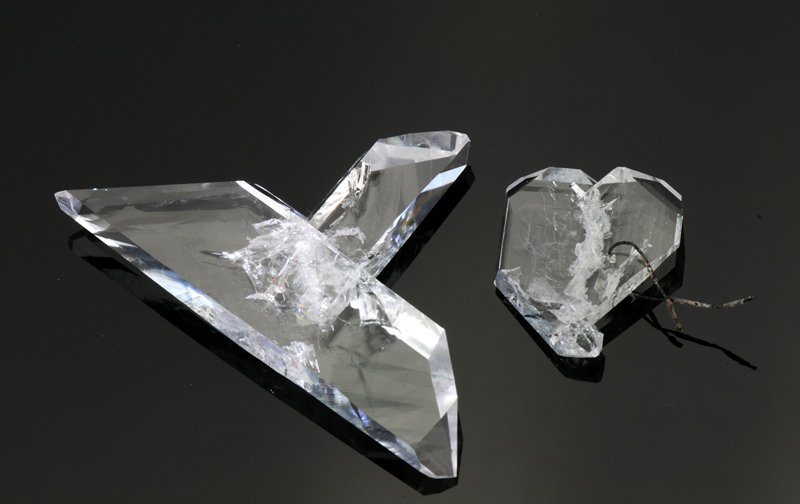
|
_________________
Elise Skalwold |
|
| Back to top |
|
 |
Elise

Joined: 22 Dec 2009
Posts: 243
Location: New York State



|
|
| Back to top |
|
 |
Jamison Brizendine
Joined: 27 Feb 2014
Posts: 128
Location: Northeast Ohio



|
 Posted: Jan 11, 2016 16:21 Post subject: Re: Quartz, Natural and Synthetic Posted: Jan 11, 2016 16:21 Post subject: Re: Quartz, Natural and Synthetic |
|
|
I promised Elise that I would start posting some of my hydrothermally grown synthetic quartz specimens on this thread. In February I posted a “smoky quartz” cluster specimen, so I thought it would be natural for me to post some of these types of specimens first. Today I will share four of these “cluster” like specimens.
Please bear in mind that my photography is not great quality. My camera is an older Kodak Z1275 Zoom camera and it has definitely seen better days!
Much of the information that was given was by personal communication with Vlad Klipov. The article cited is from Rocks & Minerals by Janet Clifford and Vlad Klipov (2015).
References cited:
Clifford, J., and V. Klipov, 2015, A marriage of science and art: Creating quartz specimens in the laboratory: Rocks & Minerals, v. 90 (4), p. 379-385
| Mineral: | Hydrothermally Grown Synthetic Silicon Dioxide |
| Description: |
R&D XTALS LLC, Cleveland, Cuyahoga Co., Ohio, United States
30 cm x 15 cm x 6 cm
This specimen (JKB533) was probably one of the specimens that took the longest in terms to completely crystallize in its current state and was one of the “early specimens”. Like a similar specimen pictured in Clifford and Klipov (2015), this specimen has masses of randomly oriented crystals and a slight pinkish color at the base of the quartz.
One thing that isn’t obvious unless you look at similar specimens is that the overall shape of the specimen (not the quartz points themselves) follows a rough semi-circular shape. The reason for this shape is because the autoclaves themselves are round.
Like many of Vlad specimens, it takes multiple runs to get a specimen to look like this and then of course there is the time factor. This specimen took approximately five years from start to finish. |
|
| Viewed: |
44101 Time(s) |
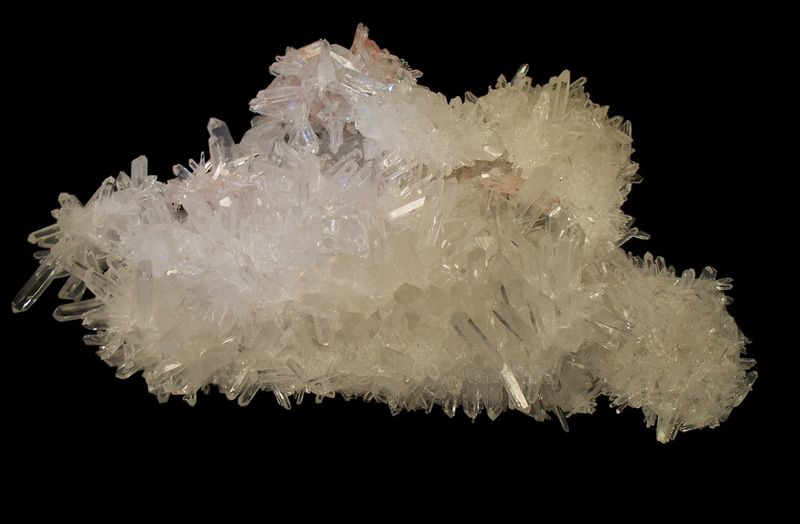
|
| Mineral: | Hydrothermally Grown Synthetic Silicon Dioxide |
| Description: |
R&D XTALS LLC, Cleveland, Cuyahoga Co., Ohio, United States
6 cm x 5.5 cm x 4.3 cm
This specimen (JKB592) is considered to be a crystal spray. Although these are very attractive, the needlelike quartz crystals are extremely sharp. At first glance this specimen does resemble a mesolite or natrolite specimen from India, but this is actually quartz. |
|
| Viewed: |
44241 Time(s) |
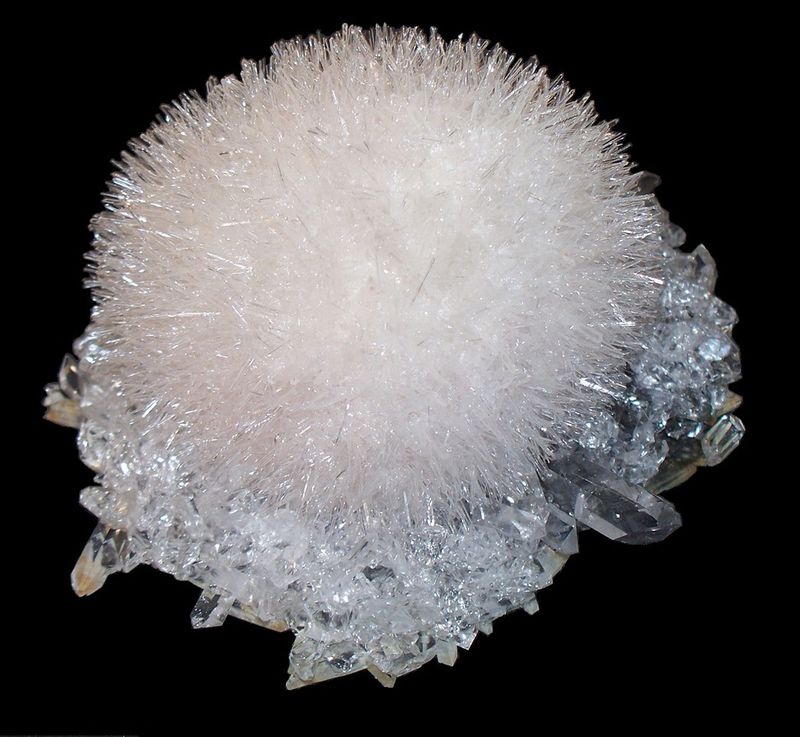
|
| Mineral: | Hydrothermally Grown Synthetic Silicon Dioxide |
| Description: |
R&D XTALS LLC, Cleveland, Cuyahoga Co., Ohio, United States
5 cm x 4 cm x 3.5 cm
This specimen (JKB643) is another variation of the crystal spray. This specimen sports longer and slightly thicker crystals than the one above. The specimen also took a considerable time longer in the autoclave to achieve these results. To me the specimen resembles a hermit crab with its two pincers holding a sea anemone on its shell. |
|
| Viewed: |
44115 Time(s) |

|
| Mineral: | Hydrothermally Grown Synthetic Silicon Dioxide |
| Description: |
R&D XTALS LLC, Cleveland, Cuyahoga Co., Ohio, United States
9 cm x 7 cm x 7.5 cm
This specimen (JKB712), shows yet another variation of the crystal spray, this time with multiple runs and new seeding sites to achieve this rather unusual shape. I affectionally called this specimen “Superman” because the main quartz crystal resembles the shape of the iconic symbol of the “Man of Steel” |
|
| Viewed: |
44036 Time(s) |
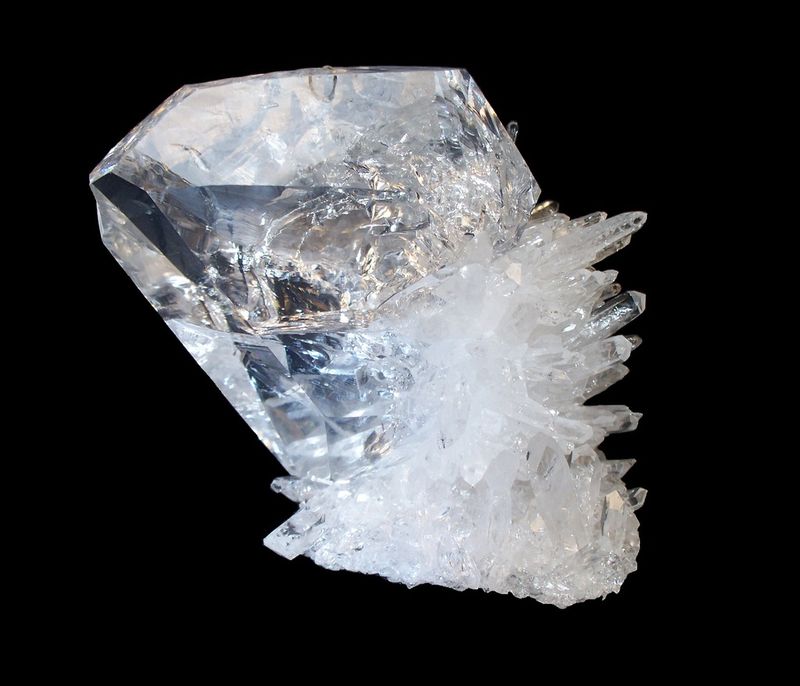
|
| Mineral: | Hydrothermally Grown Synthetic Silicon Dioxide |
| Description: |
R&D XTALS LLC, Cleveland, Cuyahoga Co., Ohio, United States
9 cm x 7 cm x 7.5 cm
This specimen (JKB712), shows yet another variation of the crystal spray, this time with multiple runs and new seeding sites to achieve this rather unusual shape. I affectionally called this specimen “Superman” because the main quartz crystal resembles the shape of the iconic symbol of the “Man of Steel”. Reverse Side |
|
| Viewed: |
43988 Time(s) |
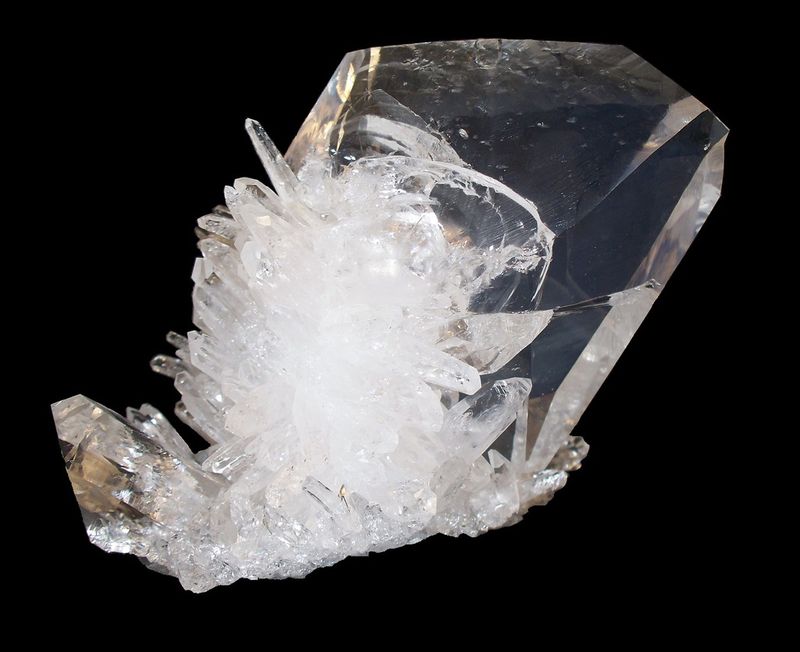
|
|
|
| Back to top |
|
 |
Matt_Zukowski
Site Admin
Joined: 10 Apr 2009
Posts: 737
Location: Alaska



|
 Posted: Jan 11, 2016 17:11 Post subject: Re: Quartz, Natural and Synthetic Posted: Jan 11, 2016 17:11 Post subject: Re: Quartz, Natural and Synthetic |
|
|
| Please do not apologize for your photos - they are great. And I love seeing what you guys are able to grow. Very interesting and thanks!
|
|
| Back to top |
|
 |
Jamison Brizendine
Joined: 27 Feb 2014
Posts: 128
Location: Northeast Ohio



|
 Posted: Jan 12, 2016 14:21 Post subject: Re: Quartz, Natural and Synthetic Posted: Jan 12, 2016 14:21 Post subject: Re: Quartz, Natural and Synthetic |
|
|
Thanks Matt for the compliment! My home setup is extremely low cost for photography. I use a cardboard box with either a black cloth or a white poster for a backdrop. Then use a tripod to fix the camera on top. Finally the flash is usually covered with some cheap paper towels to try and reduce glare. It isn’t uncommon for me to go through 15-20 digital shots, before I am somewhat satisfied with at least one.
After this process I use Paint to get rid of unwanted background elements, then autofill with black (usually), white (rarely) or a shade of gray.
Yesterday, I showed several specimens that featured clusters. According to Vlad, the clusters are easier to get desired results, because the crystals are more or less randomly oriented. Another note I forgot to mention is that many of the clusters are also artfully arranged by his wife Mila, who also plays the role of art critic!
Today, I will talk about the “Vlad Twins”, which involve a combination of engineering, art, patience and of course luck. Elise Skalwold and Jesse Fisher kindly provided some really high quality pictures on this thread already of these twins, but I also wanted to share my specimens as well.
“Vlad Twins” are the nickname for the V-shaped twins our club, The Mineralogical Society of Cleveland, came up with. These twins are an attempt at creating the elusive 84°33’, the Japan-law twin. These twins very in angles between 70 and 90 degrees, and some quartz collectors note they also resemble Reichenstein-Grieserntal twins [84°33’] (Clifford and Klipov 2015).
As stated in Clifford and Klipov (2015), twins take approximately 9 months to grow, but the larger ones, of course take more time. Of course the “exact” methods in creating these twins are a complete secret!
One final thing, the citation below should be the correct citation.
References cited:
Clifford, J., and V. Klipov, 2015, A marriage of science and art: Creating quartz specimens in the laboratory: Rocks & Minerals, v. 90 (4), p. 379-385
| Mineral: | Hydrothermally Grown Synthetic Silicon Dioxide |
| Description: |
R&D XTALS LLC, Cleveland, Cuyahoga Co., Ohio, United States
4.5 cm x 2.5 cm x 3 cm
This specimen (JKB766) is a classic example of a “Vlad Twin” or “V-Twin”. These twins are thicker than natural Japan-law twin crystals. |
|
| Viewed: |
43943 Time(s) |
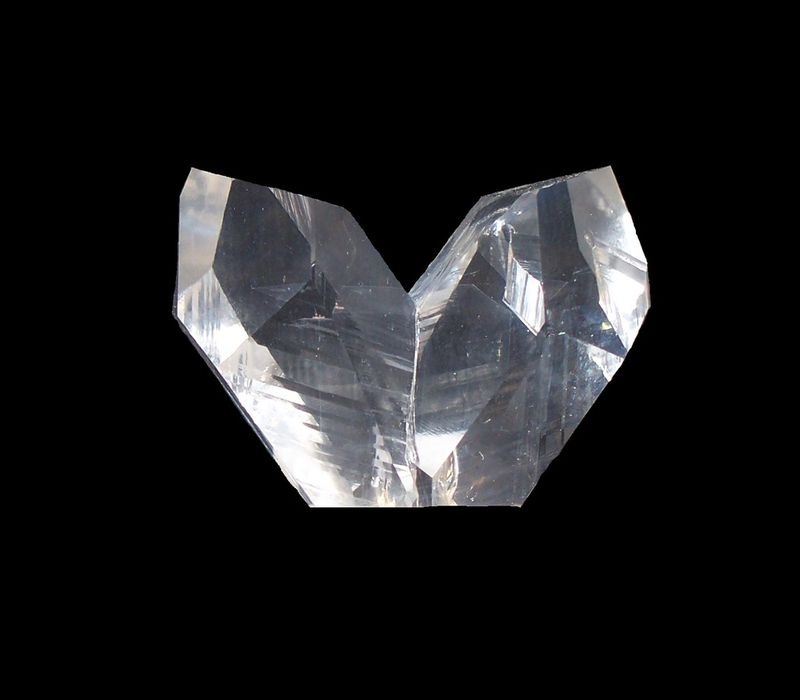
|
| Mineral: | Hydrothermally Grown Synthetic Silicon Dioxide |
| Description: |
R&D XTALS LLC, Cleveland, Cuyahoga Co., Ohio, United States
3.7 cm x 3.8 cm x 2.4 cm
This specimen (JKB906) is another example of a “Vlad Twin”. This example puts a “twist” to these aesthetic twins; it has another crystal at the back. This “tail” at the backend is rather unique and involves even more calculations and luck in trying to grow three seed crystals at the same time. |
|
| Viewed: |
43849 Time(s) |
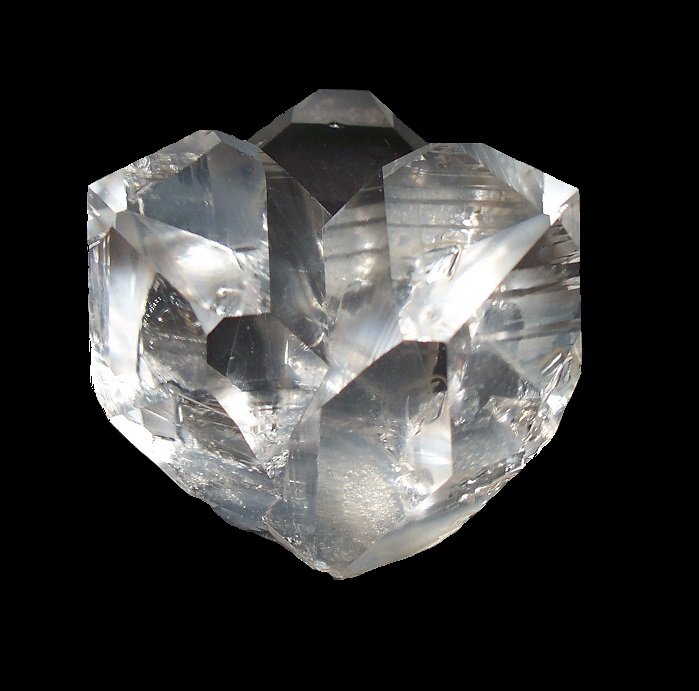
|
| Mineral: | Hydrothermally Grown Synthetic Silicon Dioxide |
| Description: |
R&D XTALS LLC, Cleveland, Cuyahoga Co., Ohio, United States
4.8 cm x 1.4 cm x 2.8 cm
This specimen (JKB834) was one of the earlier attempts at trying to make a Japan-law twin crystal. |
|
| Viewed: |
44052 Time(s) |
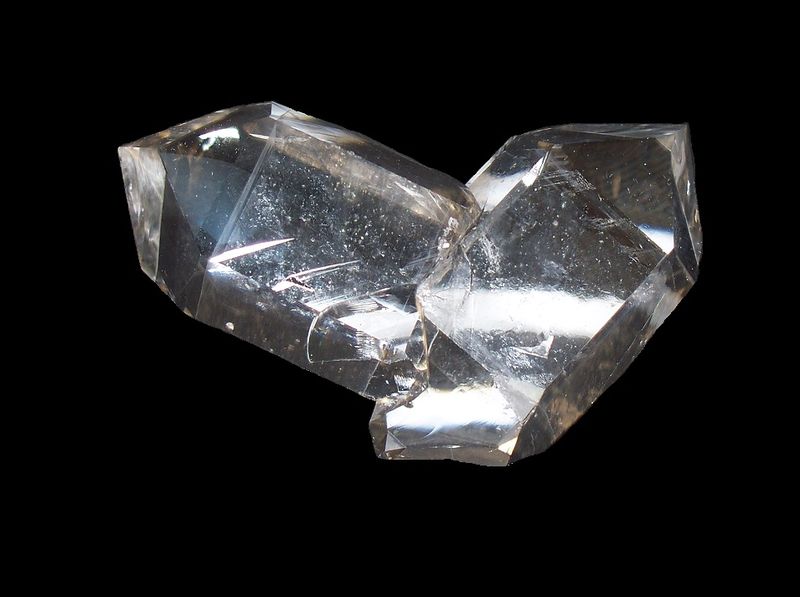
|
| Mineral: | Hydrothermally Grown Synthetic Silicon Dioxide |
| Description: |
R&D XTALS LLC, Cleveland, Cuyahoga Co., Ohio, United States
3 cm x 2.8 cm x 2.5 cm
This specimen (JKB907) is actually my personal favorite of all the “twins”. Like any art, whether it is sculpting, shading, photography, etc., trial and error is a big process. Many of the first attempts at creating twins ended up collapsing in on themselves because the angles and calculations were wrong. I call this pair of intergrown quartz crystals an “Oops! Twin” and it is a personal reminder that with perseverance and hard work, some obstacles can be overcome. |
|
| Viewed: |
43828 Time(s) |
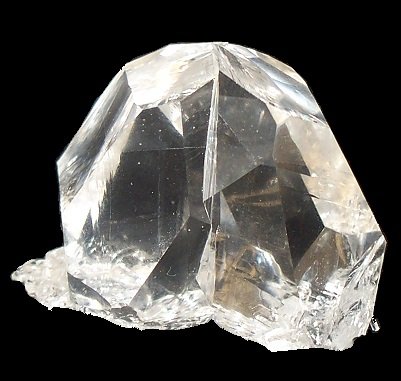
|
|
|
| Back to top |
|
 |
Jamison Brizendine
Joined: 27 Feb 2014
Posts: 128
Location: Northeast Ohio



|
 Posted: Jan 15, 2016 16:54 Post subject: Re: Quartz, Natural and Synthetic Posted: Jan 15, 2016 16:54 Post subject: Re: Quartz, Natural and Synthetic |
|
|
Today, I am going to reveal some unusual specimens of synthetic quartz crystals.
References Cited:
Clifford, J., and V. Klipov, 2015, A marriage of science and art: Creating quartz specimens in the laboratory: Rocks & Minerals, v. 90 (4), p. 379-385
| Mineral: | Hydrothermally Grown Synthetic Silicon Dioxide |
| Description: |
R&D XTALS LLC, Cleveland, Cuyahoga Co., Ohio, United States
4 cm x 3.2 cm x 4 cm
This specimen (JKB710) is a single crystal of synthetic quartz. The metallic plate is mounted in the canister. |
|
| Viewed: |
42944 Time(s) |
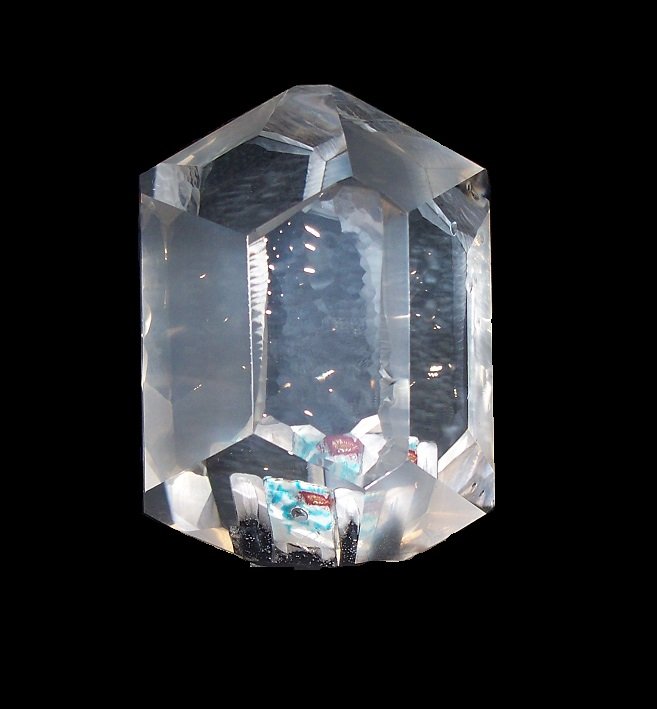
|
| Mineral: | Hydrothermally Grown Synthetic Silicon Dioxide |
| Description: |
R&D XTALS LLC, Cleveland, Cuyahoga Co., Ohio, United States
4.5 cm x 3.3 cm x 2.2 cm
This specimen (JKB662) is a single crystal with the metallic plate outside of the canister. The metal is thin enough to string a wire. Makes for a great Christmas tree ornament! |
|
| Viewed: |
42951 Time(s) |
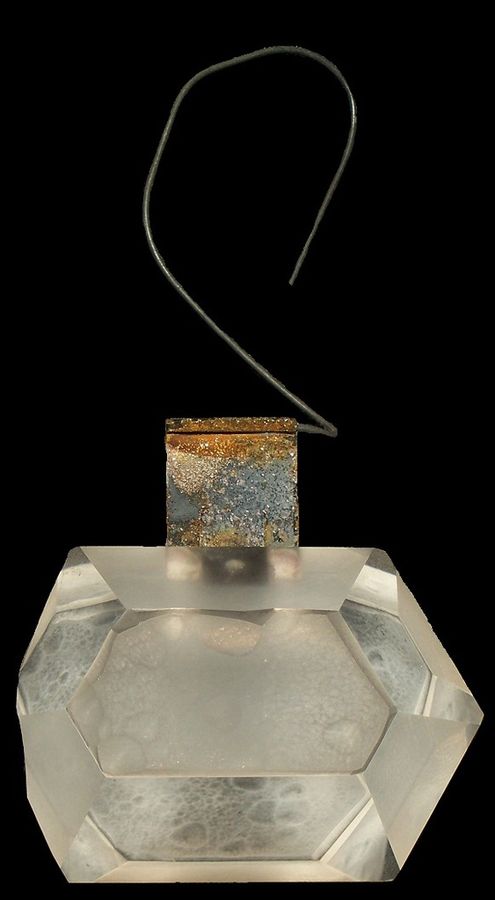
|
| Mineral: | Hydrothermally Grown Synthetic Silicon Dioxide |
| Description: |
R&D XTALS LLC, Cleveland, Cuyahoga Co., Ohio, United States
2.8 cm x 2.7 cm x 10 cm
This specimen (JKB0905) is a new development for 2015. In Clifford and Klipov (2015), Vlad revealed that one of his goals was to create scepters. This specimen is one of the many results. Its shape resembles a funnel-shaped scepter. Both ends are terminated. |
|
| Viewed: |
42972 Time(s) |

|
| Mineral: | Hydrothermally Grown Synthetic Silicon Dioxide |
| Description: |
R&D XTALS LLC, Cleveland, Cuyahoga Co., Ohio, United States
5.2 cm x 1.8 cm x 3.6 cm
This specimen (JKB908) is a rather neat example of an enhydro synthetic quartz. The bubble is easily visible toward the bottom of the specimen. |
|
| Viewed: |
42972 Time(s) |
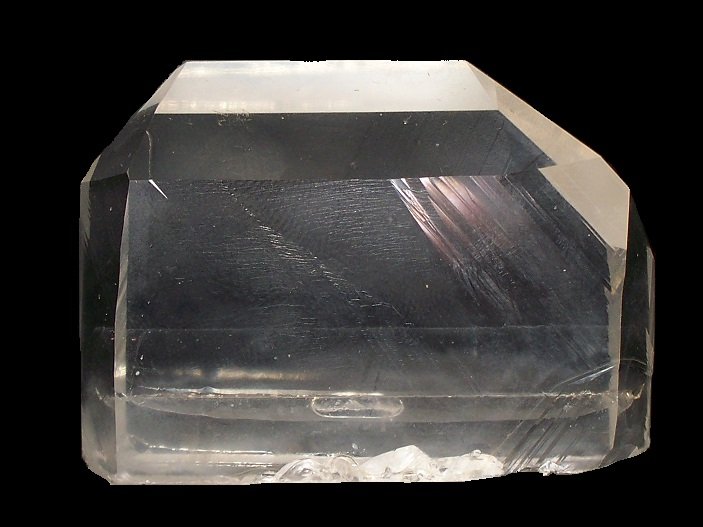
|
|
|
| Back to top |
|
 |
Jamison Brizendine
Joined: 27 Feb 2014
Posts: 128
Location: Northeast Ohio



|
 Posted: Jan 18, 2016 11:59 Post subject: Re: Quartz, Natural and Synthetic Posted: Jan 18, 2016 11:59 Post subject: Re: Quartz, Natural and Synthetic |
|
|
Today, I will be showing the last two "synthetic quartz" specimens from my collection.
Both of these specimens were originally broken pieces. Vlad inspected each one to see if it was a good candidate for the autoclave and then placed them in the autoclave over a period of many months.
The first specimen is the amethyst from Guerrero, Mexico, which has been seen on the forum and at the 2015 Tucson Show. The second specimen is a hunk of natural “rock crystal” transparent quartz that was found in Baltimore, Maryland.
| Mineral: | Amethyst repaired by Synthetic Silicon Dioxide |
| Locality: | | Guerrero, Mexico |  |
|
| Dimensions: | Before repair: 5 cm x 5 cm x 3.7 cm, after repair: 9.1 cm x 8.8 cm x 6.6 cm |
| Description: |
| This specimen is the “regrown” amethyst from Guerrero, Mexico (JKB274). This photo is the same photo that was nominated as Mindat’s “Picture of the Day”. The original color has been significantly diminished, but the luster has been improved considerably. Note the small addition of quartz at the front. This was so that the specimen wouldn’t wobble back and forth. |
|
| Viewed: |
43259 Time(s) |
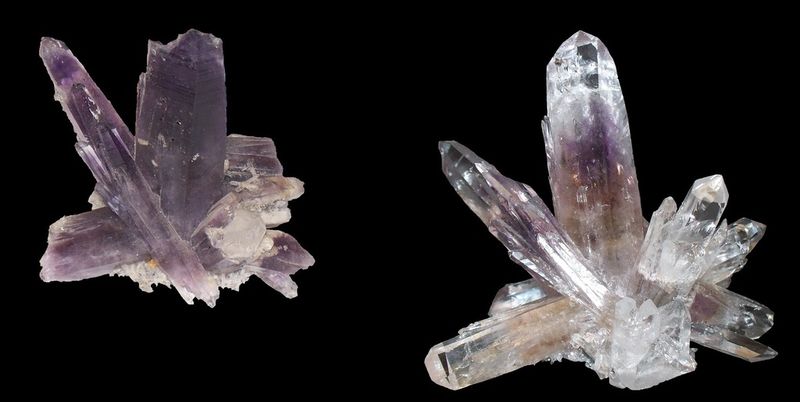
|
| Mineral: | Natural quartz repaired by Synthetic Silicon Dioxide |
| Locality: | | Baltimore, Maryland, USA |  |
|
| Dimensions: | Before repair: 8 cm x 5.5 cm x 3.7 cm, after repair: 13.2 cm x 7.6 cm x 8.8 cm |
| Description: |
| The second specimen (JKB209) is a specimen of natural quartz from Baltimore, Maryland, United States. This specimen was a fairly ordinary chunk of clear quartz, that had been obviously been fractured by tectonic forces and had partially frosted edges. Vlad inspected the piece and informed me he would attempt to try and regrow it. This is the result of this experiment.A rather unusual outcome here is that when I received the specimen back, I noticed under an ultraviolet light that the specimen did actually fluoresce a yellow color. I believe that the original specimen must have had some accessory mineral that did not dissolve in the autoclave! This certainly surprised everyone, because we all assumed that most accessory minerals would have dissolved under those conditions. I believe this mineral may be wollastonite. |
|
| Viewed: |
42760 Time(s) |
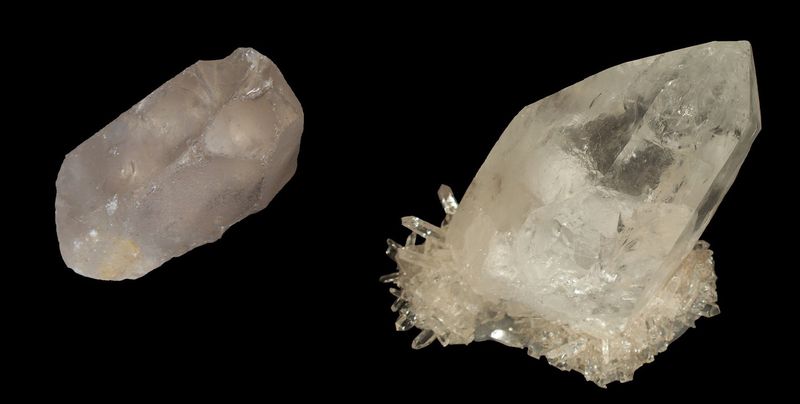
|
| Mineral: | Natural quartz repaired by Synthetic Silicon Dioxide |
| Locality: | | Baltimore, Maryland, USA |  |
|
| Dimensions: | Before repair: 8 cm x 5.5 cm x 3.7 cm, after repair: 13.2 cm x 7 cm x 6.6 cm |
| Description: |
| The second specimen (JKB209) is a specimen of natural quartz from Baltimore, Maryland, United States. This specimen was a fairly ordinary chunk of clear quartz, that had been obviously been fractured by tectonic forces and had partially frosted edges. Vlad inspected the piece and informed me he would attempt to try and regrow it. This is the result of this experiment.A rather unusual outcome here is that when I received the specimen back, I noticed under an ultraviolet light that the specimen did actually fluoresce a yellow color. I believe that the original specimen must have had some accessory mineral that did not dissolve in the autoclave! This certainly surprised everyone, because we all assumed that most accessory minerals would have dissolved under those conditions. I believe this mineral may be wollastonite. |
|
| Viewed: |
42794 Time(s) |
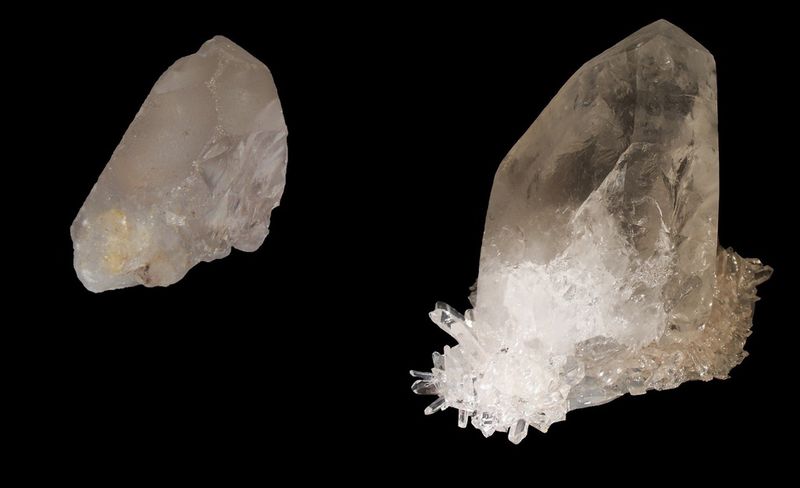
|
| Mineral: | Natural quartz repaired by Synthetic Silicon Dioxide |
| Locality: | | Baltimore, Maryland, USA |  |
|
| Dimensions: | Before repair: 8 cm x 5.5 cm x 3.7 cm, after repair: 13.2 cm x 7 cm x 6.6 cm |
| Description: |
| The second specimen (JKB209) is a specimen of natural quartz from Baltimore, Maryland, United States. This specimen was a fairly ordinary chunk of clear quartz, that had been obviously been fractured by tectonic forces and had partially frosted edges. Vlad inspected the piece and informed me he would attempt to try and regrow it. This is the result of this experiment.A rather unusual outcome here is that when I received the specimen back, I noticed under an ultraviolet light that the specimen did actually fluoresce a yellow color. I believe that the original specimen must have had some accessory mineral that did not dissolve in the autoclave! This certainly surprised everyone, because we all assumed that most accessory minerals would have dissolved under those conditions. I believe this mineral may be wollastonite. |
|
| Viewed: |
42804 Time(s) |
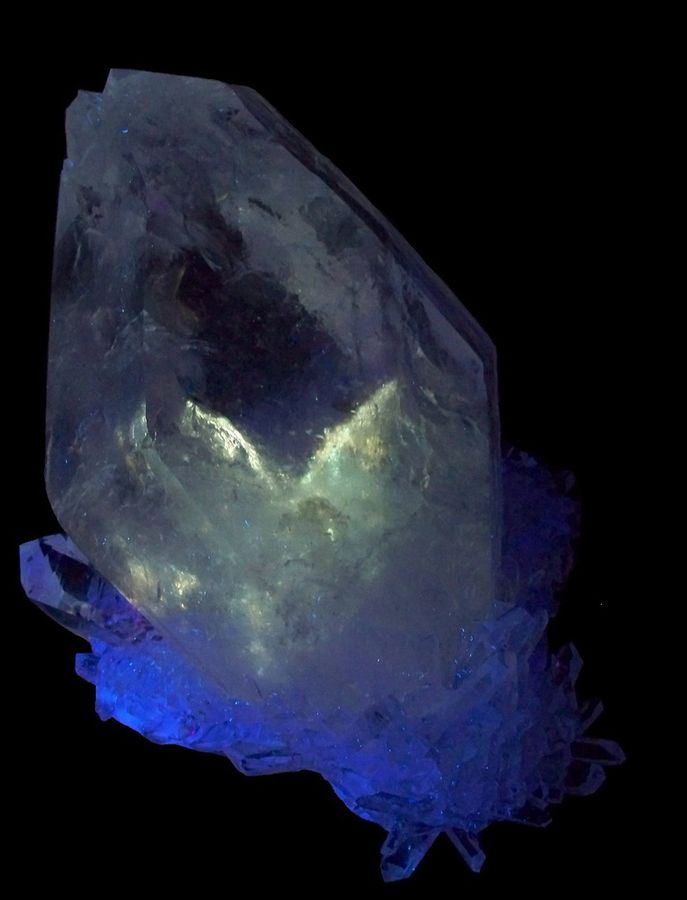
|
|
|
| Back to top |
|
 |
Indrid_Cold
Joined: 01 Feb 2016
Posts: 4
Location: Las Vegas, NV


|
 Posted: Feb 01, 2016 22:49 Post subject: Re: Quartz, Natural and Synthetic Posted: Feb 01, 2016 22:49 Post subject: Re: Quartz, Natural and Synthetic |
|
|
| Scott LaBorde wrote: | For those interested here's a great video that talks about how synthetic quartz crystals are grown, along with many fine examples of the Russian specimens.
https://www.youtube.com/watch?v=PKQOSPwodWY
(link normalized by FMF) |
I'm the producer of the Russian Quartz video.
Do you, or anyone on this board have contact info for Vladimir Klipov and R&D XTALS? I simply must add some of his crystals to my collection. Are you all aware that Vladimir was once the lead engineering scientist at Sawyer Labs?
|
|
| Back to top |
|
 |
Indrid_Cold
Joined: 01 Feb 2016
Posts: 4
Location: Las Vegas, NV


|
 Posted: Feb 02, 2016 10:23 Post subject: Re: Quartz, Natural and Synthetic Posted: Feb 02, 2016 10:23 Post subject: Re: Quartz, Natural and Synthetic |
|
|
| Jamison Brizendine wrote: | Thanks Matt for the compliment! My home setup is extremely low cost for photography. I use a cardboard box with either a black cloth or a white poster for a backdrop. Then use a tripod to fix the camera on top. Finally the flash is usually covered with some cheap paper towels to try and reduce glare. It isn’t uncommon for me to go through 15-20 digital shots, before I am somewhat satisfied with at least one.
After this process I use Paint to get rid of unwanted background elements, then autofill with black (usually), white (rarely) or a shade of gray.
Yesterday, I showed several specimens that featured clusters. According to Vlad, the clusters are easier to get desired results, because the crystals are more or less randomly oriented. Another note I forgot to mention is that many of the clusters are also artfully arranged by his wife Mila, who also plays the role of art critic!
Today, I will talk about the “Vlad Twins”, which involve a combination of engineering, art, patience and of course luck. Elise Skalwold and Jesse Fisher kindly provided some really high quality pictures on this thread already of these twins, but I also wanted to share my specimens as well.
“Vlad Twins” are the nickname for the V-shaped twins our club, The Mineralogical Society of Cleveland, came up with. These twins are an attempt at creating the elusive 84°33’, the Japan-law twin. These twins very in angles between 70 and 90 degrees, and some quartz collectors note they also resemble Reichenstein-Grieserntal twins [84°33’] (Clifford and Klipov 2015).
As stated in Clifford and Klipov (2015), twins take approximately 9 months to grow, but the larger ones, of course take more time. Of course the “exact” methods in creating these twins are a complete secret!
One final thing, the citation below should be the correct citation.
References cited:
Clifford, J., and V. Klipov, 2015, A marriage of science and art: Creating quartz specimens in the laboratory: Rocks & Minerals, v. 90 (4), p. 379-385 |
I am trying to locate contact info for R&D XTALS. They do not seem to have a web presence or email address that I can fine. Does anyone have info on how to contact and purchase from them???
| Description: |
|
| Viewed: |
42252 Time(s) |
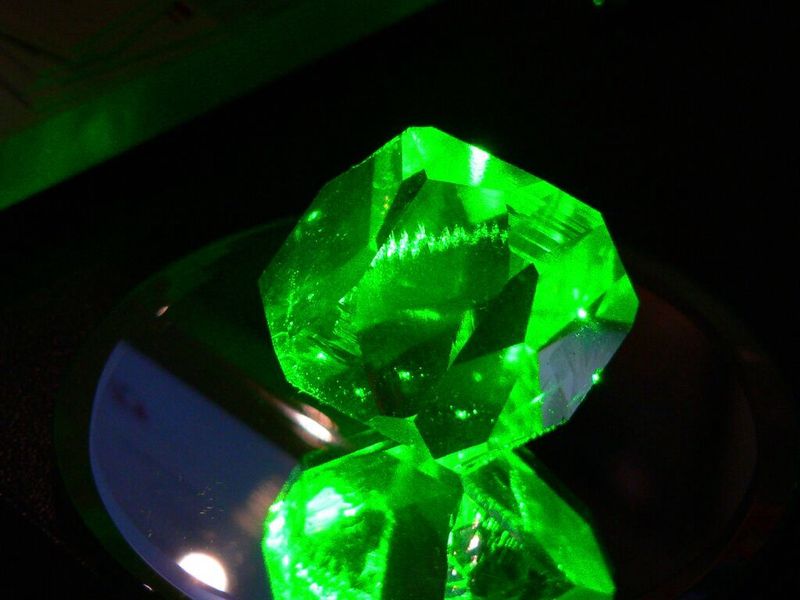
|
|
|
| Back to top |
|
 |
Enrique Llorens

Joined: 02 Jun 2011
Posts: 408



|
 Posted: Feb 02, 2016 11:09 Post subject: Re: Quartz, Natural and Synthetic Posted: Feb 02, 2016 11:09 Post subject: Re: Quartz, Natural and Synthetic |
|
|
| Vladimir Klipov 5525 Wilson Mills Highland Heights,oh 44143 Effective Date: 07/11/2005 Contact Status: Active
|
|
| Back to top |
|
 |
Indrid_Cold
Joined: 01 Feb 2016
Posts: 4
Location: Las Vegas, NV


|
 Posted: Feb 02, 2016 11:48 Post subject: Re: Quartz, Natural and Synthetic Posted: Feb 02, 2016 11:48 Post subject: Re: Quartz, Natural and Synthetic |
|
|
| Enrique Llorens wrote: | | Vladimir Klipov 5525 Wilson Mills Highland Heights,oh 44143 Effective Date: 07/11/2005 Contact Status: Active |
Thank you! Is there a web site or email available?
|
|
| Back to top |
|
 |
Enrique Llorens

Joined: 02 Jun 2011
Posts: 408



|
 Posted: Feb 02, 2016 12:17 Post subject: Re: Quartz, Natural and Synthetic Posted: Feb 02, 2016 12:17 Post subject: Re: Quartz, Natural and Synthetic |
|
|
| No, this is what I found on Google.
|
|
| Back to top |
|
 |
Indrid_Cold
Joined: 01 Feb 2016
Posts: 4
Location: Las Vegas, NV


|
 Posted: Feb 02, 2016 13:17 Post subject: Re: Quartz, Natural and Synthetic Posted: Feb 02, 2016 13:17 Post subject: Re: Quartz, Natural and Synthetic |
|
|
| Enrique Llorens wrote: | | No, this is what I found on Google. |
Thank you. I was hoping R&D Xtals had a web site. Anyone out there have any info???
|
|
| Back to top |
|
 |
Jamison Brizendine
Joined: 27 Feb 2014
Posts: 128
Location: Northeast Ohio



|
 Posted: Apr 29, 2016 13:50 Post subject: Re: Quartz, Natural and Synthetic Posted: Apr 29, 2016 13:50 Post subject: Re: Quartz, Natural and Synthetic |
|
|
These are my recently acquired hydrothermally grown synthetic quartz crystals. Two specimens are fairly typical of the popular "Sea Urchin" or "Hedgehog" style crystal clusters, while one of them was a broken Brazilian Quartz cluster, that had been partially regrown in the autoclave.
| Mineral: | Hydrothermally Grown Synthetic Silicon Dioxide |
| Description: |
R&D XTALS LLC, Cleveland, Cuyahoga Co., Ohio, United States
9.3 cm x 6.2 cm x 8.2 cm
This specimen originally was a mass of broken natural quartz crystals from Brazil. After some time in the autoclave the terminations have regrown. New growths show the cross hatch growth patterns, typical of laboratory grown hydrothermal quartz. Note the “urchin” cluster added to the specimen in the lower left corner of the specimen. |
|
| Viewed: |
19742 Time(s) |
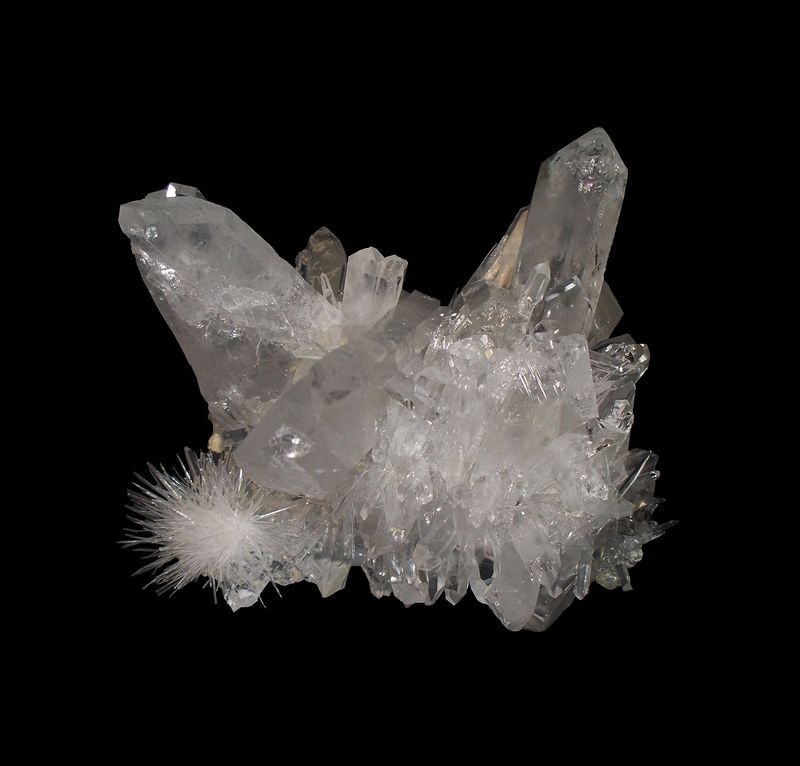
|
| Mineral: | Hydrothermally Grown Synthetic Silicon Dioxide |
| Description: |
R&D XTALS LLC, Cleveland, Cuyahoga Co., Ohio, United States
7.2 cm x 4 cm x 8.5 cm
This specimen shows three “urchin” or “hedgehog” style clusters grown on earlier seeded quartz crystals. These thin crystals are very sharp (Literally…) |
|
| Viewed: |
19681 Time(s) |
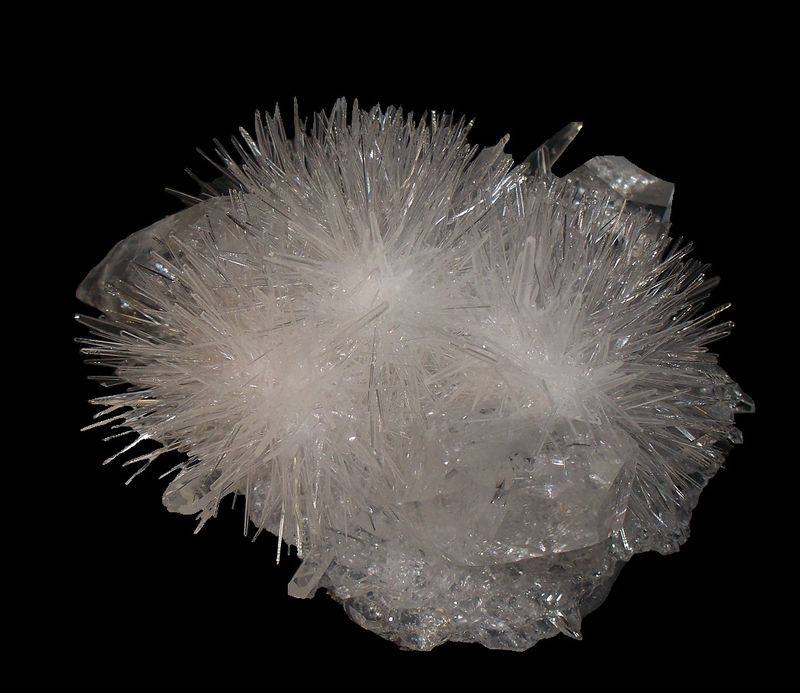
|
| Mineral: | Hydrothermally Grown Synthetic Silicon Dioxide |
| Description: |
R&D XTALS LLC, Cleveland, Cuyahoga Co., Ohio, United States
9.5 cm x 5 cm x 7.3 cm
This specimen shows an “urchin” or “hedgehog” style cluster grown on earlier seeded quartz crystals. |
|
| Viewed: |
19734 Time(s) |
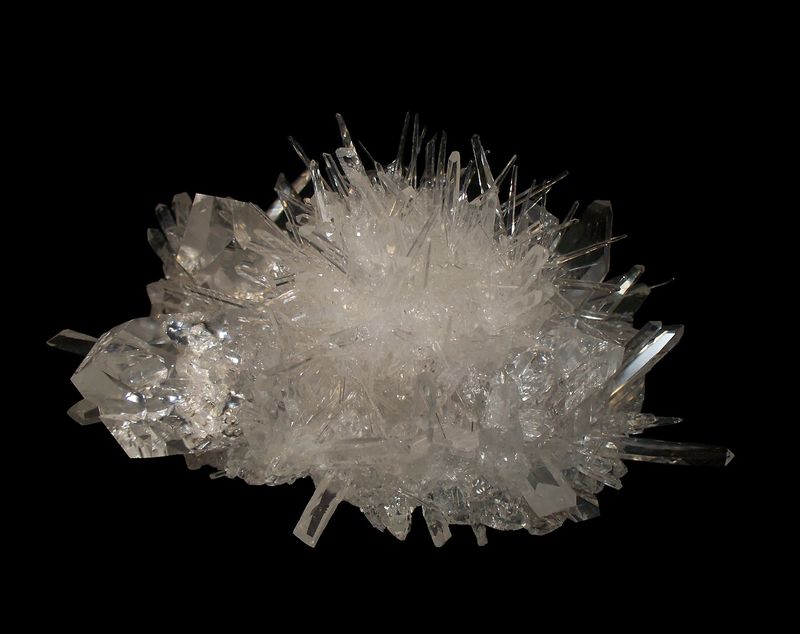
|
|
|
| Back to top |
|
 |
Elise

Joined: 22 Dec 2009
Posts: 243
Location: New York State



|
 Posted: Apr 29, 2016 14:09 Post subject: Re: Quartz, Natural and Synthetic Posted: Apr 29, 2016 14:09 Post subject: Re: Quartz, Natural and Synthetic |
|
|
| Jamison Brizendine wrote: | | ...one of them was a broken Brazilian Quartz cluster, that had been partially regrown in the autoclave. |
That is pretty neat to see Jamison - thank you so much for sharing! Is it possible to add arrows to the regrowth crystals to show where the regrowth starts and to tell how long it took to grow?
Best wishes,
Elise
_________________
Elise Skalwold |
|
| Back to top |
|
 |
|





